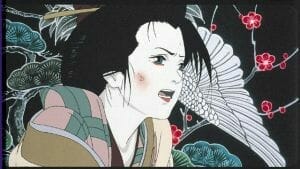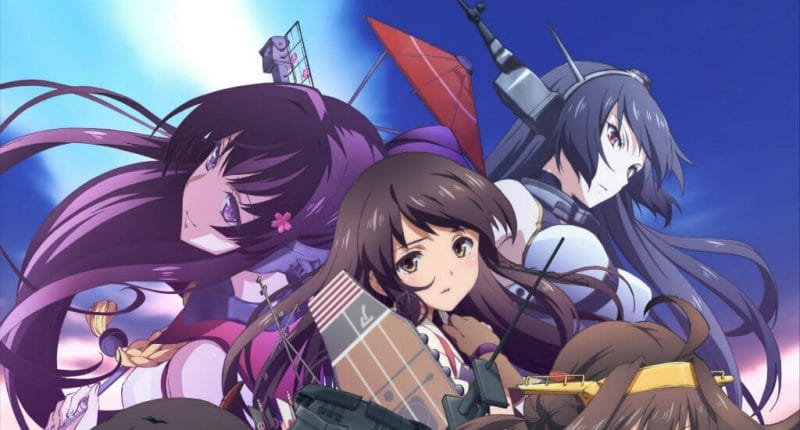Over the past ten years, I’ve had the luxury of enjoying countless programs, be they old, new, and otherwise. I’ve found new favorites, and hidden gems amidst countless turds, both polished and otherwise. With every year, I’ve managed to find a title title that stands apart from the competition. These aren’t always the “best” shows of the year, nor are they always the most impressive. Each title that I’ve seen as a standout has always been something with an unusual appeal. It’s something that rises above the norm, or has a unique appeal that isn’t always found among other shows. Patlabor had this in its subtle and charming writing. Crest of the Stars had it in amazing characterization and a believable universe.
Tonight, I’d like to go over the titles I’ve found to be particular standouts over the as ten years. I d hope you enjoy this trip down memory lane, dear reader, and I hope this piece inspires you to check these pieces out if you haven’t seen them yet.
Millennium Actress is one of Satoshi Kon’s greatest achievements. The film’s narrative traces fictional actress Chiyoko Fujiwara across her years of life on the stage and off, as she grows from a starry-eyed teenager to an accomplished starlet. Chiyoko’s story alone would have made a fascinating tale. However, Kon added his own personal touch to the film, and told it as a series of plays, within plays, within other plays. The scenes will often blend from Fujiwara’s personal life, into fantastic scenes like samurai-era wars and desolate space stations. The overall effect is an almost dreamlike atmosphere, where the anything can happen, and one is never sure of what is being told. Is it a tale from Chiyoko’s life? Is it one of her films? The film never gives the definitive answers. However, the experience is incredibly engrossing, and a testament to the late creator’s ability to make dreams come reality, and the surreal seem unsettlingly real.
 2002: Magical Shopping Arcade Abenobashi
2002: Magical Shopping Arcade Abenobashi
Abenobashi is a love-it-or-hate-it series from Gainax. The show focuses on Arumi and Sasshi: two children who are among the last families in Osaka’s Abenobashi shopping district. The arcade had seen better days, and the businesses were beginning to move out at a feverish pace. After an accident in the arcade, the two find themselves transported to a magical world, where dungeons, dragons, swords, and sorcery come to life. However, everything seems a bit… off. The inhabitants of this world are strange incarnations of the shopping arcade residents, and there’s a crazy big-breasted redhead named Mune that’s running wild! As the two youngsters try to find a way home, they find themselves pulled into even more fantastic versions of the shopping arcade, that span stranger themes, from sci-fi, to fighting tournaments, to even dating sims. At the same time, the two begin to stumble upon the truth behind the arcade, and these crazy worlds.
Abenobashi’s core strength is its ability tell a coherent, heart-felt tale in a world where every rule gets broken. As the plot winds forward, everything slowly begins to make more sense, and the narrative becomes more touching. Through it all, though, the show never loses its oddball sense of humor or charming sense of spunk.
 2003: Planetes
2003: Planetes
Planetes is a tale set in the not-so-distant future. The crew of the Technora Corporation’s DS-12 “Toy Box” take the center stage. The Toy Box is part of the Debris Section, which is tasked with preventing damage to the Earth and Moon by disposing stellar of debris – old satellites, space stations, spacecraft, and the like. The Debris Section is seen as the lowest of the low in the corporation and they must earn their stripes by pushing themselves harder and further than the rest.
Planetes is particularly notable for its realistic poratrayal of these intergalactic trash takers. The characters are brought to life through their jobs, and their aspirations are both realistic and obtainable, given the setting. The plots avoid going into the realm of the impossible, and the characters exhibits a subtle realism that is rarely seen in anime.
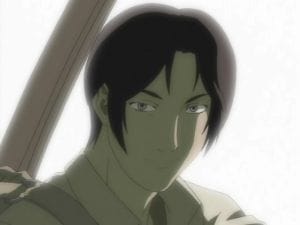 2004: Yugo the Negotiator
2004: Yugo the Negotiator
Yugo the Negotiator is a title that I can’t speak highly enough about. The show’s narrative follows Yugo Beppothrough two cases: one in Pakistan, one in Russia. The stakes are incredibly high, as Yugo’s clients are paying not only for Yugo’s services, but also for the very lives of their own loved ones or friends. Yugo travels unarmed. Instead, as he wields the power of negotiation – he allows his own words to become his sword and shield to work through the most dire of situations.
Yugo’s world is one of grays and muted hues. There are no heroes, nor are there villains. Governments are corrupt, and allies are found in the most unlikely of places. Through it all, Yugo shows a steely resolve, and an unwillingness to break as he tries to capture the heart and mind of those keeping his marks captive. Yugo is tortured, tested, and tempted through his adventures, and each episode becomes a breathless experience, as viewers are left guessing what happens next.
 2005: Ah! My Goddess
2005: Ah! My Goddess
In modern day Tokyo, Keiichi Morisato is pulled into a life that is far from the norm. Through a twist of fate, he is ensnared in a relationship with the goddess Belldandy, after a botched attempt to order food. His life changes forever, as he’s kicked out of his dorm, and another fortunate twist of fate see them taking residence in a nearby shrine. Soon, Keiichi’s life grows complicated, Belldandy’s sisters, cruel demons, and Keiichi’s meddling friends and family butt into the couple’s life.
Full Disclosure: I’m not going to lie – I’m Kosuke Fujishima’s bitch, now and forever.
With that in mind, this is a bit of a selfish choice. As a fan of the series, and a person that actually wore out my copies of the Oh My Goddess! OVA tapes back in the day, it’s a no brainer that I’d be chomping at the bit for this in ’05. So, when it finally came about, I was all over it. Simply put, Ah! My Goddess is one of the strongest adaptations to hit in the past few years. The sweet romantic moments and the light-hearted humor are given particular attention, and the cast is one that the viewer will fall in love with in short order.
Nerima Daikon Brothers is a comedy series from Excel Saga’s Shinichi Watanabe. The series is presented as a twelve-episode musical that traces the members of the titular Nerima Daikon Brothers: A singing group that desires little more than to earn enough money to buy a dome to perform in. Through their trials, they must deal with lunatic police officers, corrupt agents, and more outlandish antagonists as they solve their problems through song, dance, and good old-fashioned violence.
While the idea of anime as musicals isn’t totally unheard of (Excel Saga had a musical episode), the fact that Nerima Daikon Brothers manages to run twelve episodes without skipping a beat is simply jaw-dropping. The show brings surreal villains like Korean pachino hall owners or Michael Jackson wannabes to life with a hilariously over-the-top demeanor. The plots is told almost entirely through songs, which feature catchy melodies, memorable lyrics, and a biting wit that is too delicious to pass up.
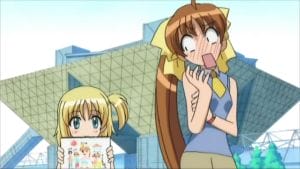 2007: Dojin Work
2007: Dojin Work
Dojin Work is a comedy series that revolves around Najimi Osana: an enterprising, recently unemployed young lass that’s entering the world of doujinshi. She isn’t attracted by the medium, or the need to fill a creative need, though. Instead, her story begins after seeing just how much money her friend Tsuyuri makes in a single spot sale. With the idea that easy money is within her grasp, Najimi sets out to become a successful doujin artist. Then reality hits. Making doujinshi is hard, and making doujinshi that people will buy is even harder! To make the possibilty of her dreams coming true even remotely possible, Najimi must hone her craft. Fortunately, she won’t be alone, as her friend Tsuyuri and a gaggle of colorful doujin artists are willing to lend a hand whenever, and wherever they can.
The series stands out due to its humorous, yet somewhat realistic portrayal of the doujinshi world. Najimi’s a self-serving woman, and the various manga artists are either depraved creeps, or eccentric beyond belief. This isn’t the “friendship solves everything!” types of shows, like Comic Party of Animation Runner Kuromi. Instead, it’s more of a freak show, that displays the absolute worst of the doujin world, and places it behind a cute, unassuming veneer to produce a hilariously twisted experience.
 2008: Persona: Trinity Soul
2008: Persona: Trinity Soul
If you’ve been reading long enough, you’ve heard me rave about what Persona: Trinity Soul is, and why it’s awesome. And, you’d also know why I have a long-standing hatred of Shoji Meguro’s body of work.
Joking aside, Persona is a striking, somber show that diverges greatly from its source material. The show is primarily a character drama – one that deals with the crushing themes of love and loss, acceptance and guilt through the eyes of the main casts. Every character is a person – each with ideals, motives, and desires. The Personas are the manifestations of these human aspects. They’re beings of fear, of hate, of simple facade that get the major cast members through each day. Everything is handled in a wonderfully subtle manner, and outright heavy-handedness is kept to a minimum. Instead, actions speak, and dialogues are meaningful. The viewer gets to see the sheer will of the cast, the lives they live, and how they simply go on, even in the most extroardinary circumstances. The experience is simply astounding.
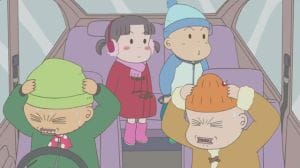 2009: Mainichi Kaasan
2009: Mainichi Kaasan
Mainichi Kaasan is the semi-autobiographical tale of manga artist Rieko Saibara. The show recounts her daily life, as she juggles two hyperactive kids, an alcoholic husband, a domineering mother, and her career as a manga artist. Whether it’s Bunji’s reluctance to learn kanji, or a busy day at the zoo, there are plenty of opportunities for things to go awry, and for Rieko’s temper and sanity to be tested.
The show stands out due to its sheer simplicity. The show sticks by the idea that the truth is often stranger than fiction. As such, there are no crazy plots, no over-arching narrative, and no real action whatsoever. The show is instead told much like a series of anecdotes. The goofy sense of humor is mixed with a sentimental, almost almost wistful tales that make one really think about how fun, and how humorous our everyday lives really can be.
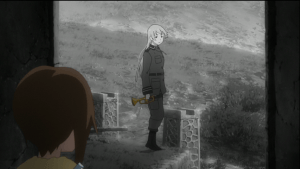 2010: Sound of the Sky
2010: Sound of the Sky
I’ll be honest – my experiences with 2010’s shows aren’t as extensive as those with previous years – I work with the Region-1 (or Region A for Blu-Ray owners) currents, which means that I usually operate on a one-year lag. However, Sound of the Sky is one of the strongest titles I’ve seen so far. The show has a simple, quiet charm that allows the brilliant character writing to shine. The lives of Kanata, Rio, and the rest of the residents of Seize are the true centerpiece, displayed through the lens of Kanata, who only desires to to become all that she can as a soldier and a musician in a world ravaged by a recent war.
The show features a striking sense of style, with gorgeous backdrops, and a truly remarkable Yuki Kajiura soundtrack. Much like a great orchestra, every element, be it visual audio or otherwise combines to form a magnificent opus that deserves a spot on any aficionado’s shelf.


